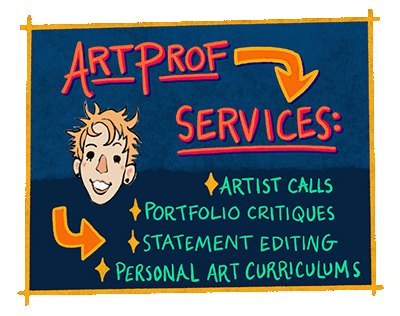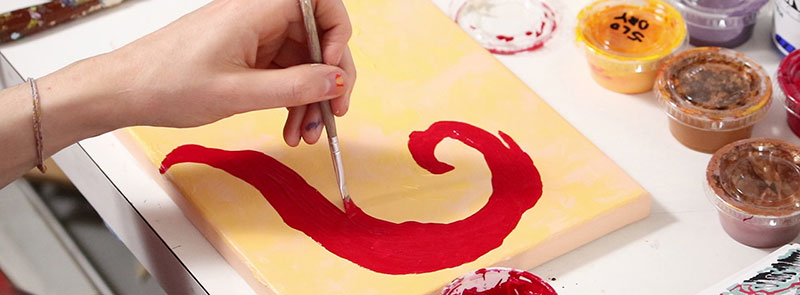Prompt
- Paint a self-portrait from life, using only a palette knife.
Painting from Life
We understand that painting from life often doesn’t feel as easy or convenient as working from a photograph. Seeing colors in real life is actually easier than observing a photograph, where colors lose their sophistication and nuances.
Painting from life provides the opportunity to observe colors and subtle shifts in those colors that you cannot get from a photograph. For this prompt, that’s really important.

Photographs cannot capture the true experience of color in real life. Many areas that can be vibrant in real life end up looking very flat and dull in a photo. More on painting from life vs. photos.

Examples
JenK, Jen Noelle, Johanna, Ashley Tanelle, Raven Kushner
palette knives
There is no “correct” palette knife to get, every artist has their own preference. Plastic palette knives are less expensive, but they are thicker and less flexible than metal ones, and therefore are tougher to work with.

We recommend investing in a set of metal palette knives. The best way to choose one is to try out several shapes and see what works for you.
Natural light vs. Artificial light
Natural light produces cool highlights and warm shadows, while most artificial lights have warm highlights and cool shadows. This painting below has cool blue highlights on the left, and warm shadows on the right.

Choose whichever light is the best fit for you, but if you have never worked from natural light, we highly recommend trying it! Find a window that has soft, diffused light that will stay consistent as you paint.
South light is very bright, but will change every 10 minutes and therefore is impossible to paint from.
Inspiration
Jenny Saville, Lucian Freud, Alice Neel
Hear from an Art Prof Student

“I learned a portrait doesn’t have to be a stale, boring sitting pose but can tell a full story with emotion, with proper planning. I learned texture is crucial.
Sometimes you don’t have to draw every line, things can be hinted at or implied. I learned to push things further than you think they need to be pushed and you can always pull back if you need to later.“
Jen Noelle

Tips
- The final artwork is not important in this prompt! You will end up with very sloppy, vague looking paintings.
- Give up on trying to make a “good painting,” this prompt is about the experience of mixing colors, think about the painting as the “leftovers” of that experience.
- Don’t worry about likeness, painting details, (you can’t get details with a palette knife) or making a good painting, that will get in the way of the experience of mixing colors.

- The primary object is to focus on your mixing skills and really get to know your palette knife.
- Often when we paint with brushes, we don’t use our palette knives nearly enough to mix colors, or as remotely aggressively as we can.
art media
This prompt is best suited to any opaque paint, like acrylic, oil, water mixable oils.
Gouache and acryl gouache don’t tend to work well with a palette knife, and you’ll go through an absurd amount of paint which gets very expensive very fast.

We don’t recommend trying this prompt with drawing supplies, as the prompt gets lost in translation.
SUPPLY LISTS
Visit these pages for specific supply lists: acrylic, oil, water mixable oils, gouache, acryl gouache, soft pastel, oil pastel.
Palette Knife Self-Portrait Paintings
See a painting demo of how to mix flesh tones using water mixable oil paints and a palette knife. Using exclusively a palette knife is an effective way to focus entirely on the color mixing process by removing the distraction of needing to address brush technique at the same time.
Painting a self-portrait from life, you’ll see how to observe colors in the skin. Demo by Art Prof Clara Lieu.
Light & Shadow in Portrait Painting
This video explain show lighting can be used in paintings to show form in a portrait. You’ll see how to break down the specifics of light and shadow: direct light, reflected light, shadow core, types of shadows, how light effects color.
Lighting can establish a mood or narrative for a painting, and more. Lecture by Art Prof Clara Lieu.
- Video Walkthrough & more
- Watch the 6 min. version
- Watch the 63 min. version
Warm & Cool Colors
This video explains how warm colors and cool colors can be used to create mood and contrast in an artwork. While there are colors that are stereotypically seen as “warm” and “cool,” warm and cool colors are contextual, and is often times not as straightforward as it might seem!
Discussion led by Art Prof Clara Lieu and Teaching Artists Alex Rowe and Lauryn Welch.
As a free educational source, Art Prof uses Amazon affiliate links (found in this page) to help pay the bills. This means, Art Prof earns from qualifying purchases.







